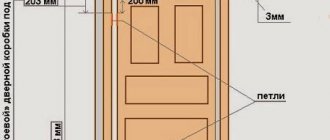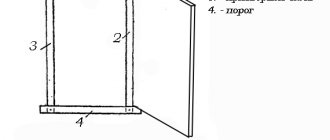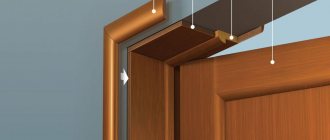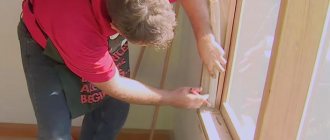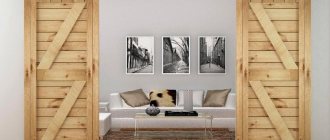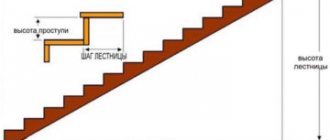Home / Boilers
Back
Published: 06/04/2020
Reading time: 5 min
0
1645
The word “boiler” has become widely known; today it is almost difficult to find an apartment or house that does not have such a water heating device.
Installing a boiler in an apartment has become relevant not only in houses where there is no central heating supply, but also in those where there are hot water supply networks. An unpretentious, compact boiler has become a reliable source of hot water supply for millions of Russian citizens.
- 1 Norms and rules for installing a boiler in an apartment
- 2 Required tools and materials
- 3 Select the location for installing the water heater
- 4 Installation instructions for the boiler 4.1 Mounting to the wall
- 4.2 Connection to water supply
- 4.3 How to connect to power supply
The main mistakes made when installing a boiler
If the homeowner decides to independently connect the storage water heater, under no circumstances should the following things be done:
- replace the components supplied with the device;
- connect the device to the AC power supply if there is no water in the tank;
- disassemble the device when connecting a water heating device to the electrical network;
- turn on or use an ungrounded device;
- operate equipment with inappropriate water pressure parameters in the central water supply;
- Completely drain the water from the tank while the storage boiler is operating.
And most importantly, under no circumstances should safety precautions be neglected when connecting a boiler - a fairly powerful electrical appliance. If you have any doubts about the correctness of carrying out installation work yourself, it is advisable to seek help from professionals.
To understand what water heaters are, how to connect such devices and what are the benefits of using them, you do not need to be a professional electrician or builder. All installation work can be performed by every person who is at least slightly familiar with the structure of the water supply system and can understand the simplest electrical circuits. The main thing is attentiveness, following all safety rules and, of course, desire, without which it is better not to take on such work on your own.
https://youtube.com/watch?v=HA9JlpwQXTI
Types of storage water heaters
One of the most important criteria for choosing a device is its type according to the connection method. There are two types of such devices.
Type #1: Storage type pressure equipment
Used in systems where the water pressure is constant. In this case, the type of water supply does not matter; it is important that pressure is maintained in the main line. Pressure devices have many advantages:
- Constant availability of hot water, since the device’s tank is never empty. As heated water is consumed, cold water is poured into its place under pressure.
- Good water pressure. It is determined by the maximum pressure in the pipeline and is usually quite high, especially compared to its non-pressure counterpart.
- Easy to connect to the power grid. Considering that the device has a power of 3-4 kW, there are no problems with the electrical network.
The equipment also has disadvantages. The most significant is the rapid decrease in temperature in the tank when a large amount of cold water enters.
The low power does not allow the heating element to quickly heat the water, so you have to wait until the device copes with its task. This drawback is especially noticeable in small-volume devices.
For example, a 50-liter tank when using a shower with a flow rate of 3-5 liters of water per minute in just 15 minutes. will be filled with cold water. To continue water procedures you will have to wait a while.
This disadvantage is offset by the correct choice of device volume.
Type #2: Non-pressure storage water heaters
The equipment is designed to work with pipelines in which there is no constant pressure. Water is supplied to the tank using a pump that is turned on manually or automatically.
In the latter case, a float switch is mounted inside the container. Many people consider the non-pressure system inconvenient and outdated, but in some cases its use is quite justified.
For example, the device would be very appropriate in a country house whose owners do not want to equip a full-fledged plumbing system. The advantages of non-pressure equipment include:
- Low power consumption, which allows the device to be installed in houses with old wiring.
- Easy to install and connect.
- Slow mixing of hot and newly incoming cold water inside the tank.
There are not many disadvantages to non-pressure water heaters. Among them is low power, which forces you to wait quite a long time until the water warms up to the desired temperature.
In addition, you need to remember that the liquid enters the container slowly. Therefore, the water level may drop below the minimum mark, and this will lead to failure of the heating element.
It is important to always monitor this moment.
When choosing a location for a water heater, it is important to consider its type. Horizontal models should absolutely not be placed vertically, otherwise serious equipment damage will not be avoided.
The procedure for connecting a water heater - preliminary work
Preliminary work begins with the installation of the water heater. Moreover, first you need to choose the optimal location of the column or boiler.
The first type of heating devices - the column - should be located close to the free valve of the household gas pipeline (no further than 2-3 meters), in a well-ventilated room.
A storage boiler can be installed literally anywhere. After all, electricity and water can be supplied anywhere. But before connecting the boiler to the water supply, it is necessary to take into account the heavy weight of the filled heater and the accumulative “nature” of this device, which limits the volume of hot water consumed.
Having decided on the location of the water heating device, you need to attach the column or boiler to the supporting surface. For the boiler, this stage proceeds as follows:
- Holes are drilled in the wall for anchor bolts, the position of which can be determined by “trying on” the empty (and light) water heater to the surface.
- Next, the boiler is “attached” to the wall, driving mounting anchors into the holes through the eyes in the heater brackets.
- You then simply tighten the anchor bolts, locking the fastener into the hole.
- Finally, you connect the heater to the mains. To do this, it is advisable to draw a separate line from the central panel using a 4 mm three-core cable. Well, as a plug and socket you should use a separate residual current device - a fuse, to which the electrical line and cord from the boiler are connected. Moreover, the installation of a separate line and RCD must be completed before connecting the boiler to the water supply.
A gas water heater requires a lot of trouble:
- First, you put a galvanized sheet on the wall, the dimensions of which coincide with the supporting edge of the speaker body. However, galvanization can be replaced with tiles or fire-resistant plaster.
- Next, you “try on” the speaker to the wall, marking the location of the fasteners along the lugs of the brackets of your speaker body.
- The next step is drilling the mounting holes.
- Next, you mount the column on the anchor bolts, driving them through the eyes and tightening them until they stop.
- The last stage - connecting the dispenser to the gas pipeline - is carried out only by a representative of the territorial gas industry. Self-connection may cause an accident or a fine for illegal tapping into a gas pipeline.
After completing the installation of the heater, you can proceed to connecting it to the “cold” water supply.
Preparing to connect
When planning to install a boiler yourself, you need to carefully work out the work plan. This stage is a very important one and any mistake made by the master can complicate the further process.
The stage includes the following actions:
- The master performs calculations and selects the necessary anchors. The thickness of the mounting bolts is set depending on the weight of the filled tank. Since the fasteners will be constantly under load, it is necessary to allow for an error in the calculation. It is better to take massive anchors.
- Make a hole in the wall and screw a metal base plate to it. The unit will hang on it.
- A metal strip is attached to the heating device, which is mounted on the wall. For reliability, it is tightened with bolts.
It must be taken into account that the heater must be positioned strictly horizontally or vertically. Even a slight tilt is unacceptable, so marking is carried out using a mounting level. After completing the preparatory work, they begin to connect the device to the water supply system.
Installation Rules
If you decide to install the boiler yourself, then you need to clearly know how to do it. Mistakes made during installation will lead to burnt out wiring, flooding of the home, and failure of the device. Let's consider the basic rules for installing a water heater:
- First you need to choose the optimal location of the device. The boiler is usually installed in the bathroom, toilet or kitchen. Electrical appliances are provided with free access.
- The wall or any other support for the boiler must withstand double the weight, for example, with a capacity of 80 liters, the load indicator is 160 kg.
- Old wiring must be replaced, otherwise it simply will not withstand the load.
- The wiring of ten-year-old metal pipes will similarly have to be changed.
Other rules and installation nuances will be specified in the installation instructions.
Electrical connection
To begin with, we want to introduce you to the basic rules for connecting a water heater to the electrical network. Compliance with these recommendations will allow installation to be carried out as safely and efficiently as possible.
- The socket for the boiler must be located in a place inaccessible to water splashes. Experts strongly advise using special waterproof sockets for these purposes.
- The water heater can only be turned on when the ground is connected to the electrical outlet. This can be done using a three-core wire (in this case, the socket must also be designed for three poles).
After making sure that all safety rules will be followed, you can proceed directly to work. The procedure will be as follows:
- measure the distance between the installation location of the water heater and the outlet;
- disassemble the device plug into elements;
- remove the insulating material from the cable;
- we strip the veins using side cutters;
- armed with a soldering iron, we connect the wires to the plug contacts (red - to phase, yellow/green/black - to ground; blue - to zero);
- remove the water heater panel and open the contacts;
- we strip the conductors at the opposite end of the cable;
- connect them to the contacts of the device and return the panel to its place.
You can connect to the electrical network differently - connect the water heater directly to the panel. In this case, you need to proceed as follows:
- lay the cable from the device to the electrical panel;
- We install an automatic machine near the water heater;
- we run the cable through the machine;
- remove about 100 mm of insulating material from the cable;
- we expose the phase from the machine;
- We connect the phase from the machine to the upper terminal, and from the water heater to the lower terminal;
- remove the insulating material at both ends of the cable, free the cores;
- remove the boiler cover, connect the wires to the device terminal;
- turn off the current supply and connect the heater to the electrical panel.
The following video shows water heater connection diagrams and their descriptions, which will help you understand how to connect the boiler correctly.
What is required for installation?
Before installing an electric or gas boiler, you need to allocate a suitable place for it, taking into account the following points:
- placement of a water heater in an apartment or private house should be done taking into account ease of use and maintenance;
- it must be taken into account that when emptying or repairing the apparatus, a significant part of the water may spill onto the floor;
- It is convenient to connect the water heater yourself when the water supply and electrical networks are nearby and in the same room;
- Do-it-yourself installation and connection of a gas boiler involves connecting a pipeline supplying natural gas to the room.
Based on the listed conditions, the installation and connection of a storage water heater can be performed in the following areas of a private house or apartment:
- kitchen - above the sink;
- bathroom - above the bath;
- boiler room - above the tiled floor.
Before deciding how to connect the boiler to the water supply, you need to hang it from the wall. To complete all work, you will need an electric drill with an impact function (or a hammer drill), carbide-tipped drill bits and a standard set of plumbing tools, including a gas and adjustable wrench. The boiler connection diagram is assembled from the following elements and materials:
- check valve with safety valve in one housing (usually included with the boiler);
- bronze tee DN 15 (1/2");
- ball valve DN 15 (1/2") - 3 pcs., 2 of them - with American connection;
- pipes for connection (usually metal-polymer);
- FUM tape, flax or special thread for sealing joints.
https://youtube.com/watch?v=HA9JlpwQXTI
There is also an electrical diagram for connecting the boiler, according to which it is necessary to purchase differential circuit breakers for a current of 16 A (2 pcs.), a socket and plug with a grounding contact, as well as a power cable of the required length. The connection of a device operating on natural gas is carried out using a gas hose.
Features of connecting a flow-through boiler
The flow-through design of an electric boiler, as in the photo, is installed directly into a branch of the water supply system intended for supplying hot water.
- The water supply in the central pipeline is cut off.
- At the point where the heating device is inserted, the pipe is cut, creating a rupture.
- Shut-off valves are attached to the ends of the breaks, which will allow repairs to be carried out in the future without shutting off the central water supply.
- Hoses connecting the boiler with shut-off valves are screwed onto the inlet and outlet pipes of the flow-through water heating system.
When independently carrying out work on dismantling heating equipment, instead of the central water supply, turn off the tap installed on the inlet pipe and only after that on the outlet pipe. Also, when using a flow-through water heating device, first turn on the water and only after that the heating device. If there is no need for hot water, then turn off the power supply and then the water.
Figuring out how to connect a boiler correctly is not that difficult, the main thing is to have the desire. But to be more confident, you can practice on pipe scraps so as not to spoil the main elements of the system. This will allow you to gain experience and avoid stupid and unnecessary mistakes.
Examples of connecting a boiler to a water supply
Advantages and disadvantages of boilers
The popularity of electric boilers is largely due to their many advantages. The advantages of this technique include the following:
- Ease of use.
- Affordable price.
- Minimum power consumption.
- Availability of fully automatic control.
- Complete security.
- Availability of wall and floor options.
- Possibility of self-installation.
Servicing electric boilers is not particularly difficult and can be performed by the homeowner without resorting to specialists. All you need to do is inspect the storage tank for corrosion and inspect the heating element, on which various calcium deposits may appear, reducing heating efficiency.
The presence of such deposits leads to a slight increase in energy consumption for hot water supply.
Step-by-step instructions for installing a storage boiler
The installation diagram for a storage boiler is a little more complicated. Here you will need to correctly route the pipeline, securely secure the tank, and make electrical connections.
Choosing a location for the tank and its installation
The storage container takes up a certain space in the room, so it must be placed efficiently so as not to take up unnecessary space. But at the same time, the boiler should be located as close as possible to the water supply points. The remote location of the water tap from the heater increases the wait for hot water to arrive.
Convenient placement of a storage boiler with a separate bathroom
The mounting location is selected according to the layout of the room:
- The layout in a private house is different from apartments. Here the bathroom, toilet and kitchen can be located far from each other, and one boiler must supply hot water to all rooms. Here you need to determine the important room where heated water should be supplied first and install a water heater closer to it;
- The traditional layout of the apartment provides for the combination of all these rooms, so choosing the location of the tank here will be easier.
Most often, the tank is installed above the toilet. It does not take up useful space and is located close to the sewer, which makes it convenient to drain water from the safety valve. The unit is secured to the wall with anchors. A water tank has a lot of weight, so if the wall is loose, an additional support is welded under it from a profile pipe.
Connecting the water supply
The optimal connection option is considered to be a circuit with the ability to drain water from the container.
The step-by-step execution of the work looks like this:
- The house is disconnected from the cold water supply, and the hot water riser in the apartment is additionally shut off. The collection of all components of the circuit begins from the water heater suspended on the wall. To seal the connections, flax or FUM tape is wound around the threads.
- At the bottom of the tank there are two threaded pipes. On the right is the cold water inlet, marked in blue, and on the left is the hot water outlet, marked in red. Packing begins with cold water.
- A brass tee is screwed onto the inlet pipe. It must be turned with a transverse hole in a convenient direction to drain the water. A ball valve is screwed into the same hole through a brass adapter. A pipe with a hose for draining water is connected to it. A ball valve is also screwed into the downward thread of the tee to shut off the supply of cold water inside the container.
- Now it’s time for the most important thing – the safety unit. The boiler is equipped with a safety valve, which is mounted immediately behind the lower valve on the tee. To install it correctly, there is a guide arrow on the body. On the side of the valve there is a fitting for bleeding water. A transparent reinforced hose is attached to it with a clamp and lowered into the sewer.
- Original valves are not always reliable, so they often buy a “safety group” separately. It consists of a check valve installed on the tap coming out of the bottom thread of the tee. The safety valve is installed separately on the middle outlet of the tee.
- Next, it remains to supply cold water. This can be done with any pipes, for example, metal-plastic or eco-plastic, if desired. In order not to cut the main water supply pipe, the connection can be made through a tee, installing it on the threaded connection of the toilet tank or washbasin tap.
- The hot water unit is assembled in the same way as the cold one, only without a valve. In a private house, from the outlet of hot water from the boiler, pipelines are laid to water supply points. In the apartment, the water heater outlet is connected to the hot water supply pipeline. In this case, when the boiler is operating, close the tap on the riser supplying centralized hot water.
At this point, the water heater is connected to the water supply system, all that remains is to connect the electrical wiring and can be used for its intended purpose.
https://youtube.com/watch?v=HA9JlpwQXTI
Installation of a storage water heater
First, the location of the boiler is selected. It must have good access for maintenance.
Then all measurements are taken and holes are drilled for installing mounting hooks.
Additionally, it may be necessary to install safety bolts.
Another way.
Then the water supply is connected. If only a pipeline with cold water enters the house, then a tee is cut into it, and a shut-off valve is installed on it.
A safety valve must be located at the inlet to the boiler, which ensures that the required pressure is maintained in the boiler.
Since this valve has a water outlet, you will need to connect a silicone tube to it, the end of which should be drained.
A hose is connected to the outlet of the boiler, through which hot water will be supplied to the pipeline leading to consumers.
Therefore, it is advisable to lay this pipeline in advance.
Afterwards the heater is connected to the electrical network. It is best to make the connection to the distribution box located closest to the meter. Now you can use smart sockets for these purposes, but you need to know the models that can withstand heavy loads.
It is advisable to lay the wire in a groove and then seal it. A circuit breaker must be installed in the wiring near the boiler.
Schematic diagram of boiler installation.
If a pipeline with hot water also enters the house, then it will be necessary to insert the outlet pipe from the boiler into this pipeline and install another tee and two additional taps.
Afterwards you will need to pump the heater with water. To do this, you need to open one of the taps at the point of consumption, and then open the water supply tap to the heater.
If there is a connection to a centralized hot water pipeline, the tap installed in front of the tee must be closed and the tap at the outlet from the boiler must be opened.
Water, filling the system, will push out the air present in the system and it will exit through the tap at the point of consumption.
During injection, all pipeline connections must be inspected for leaks.
If necessary, the connections can be tightened. If the leak persists after tightening, it is better to repack the connection, first turning off all supply taps and draining the water from the system.
Examples of boiler installation.
After filling the systems with water, the boiler is connected to the network.
Water heater and autonomous water supply
Autonomous water supply is often gravity-based, that is, the water source is a tank installed in the attic, into which water is pumped using a pump.
What matters is the height difference between the outlet fitting of this tank and the water heater:
- If less than 2 m: a tee is screwed directly to the outlet fitting of the tank, the branches of which are connected by pipes to the mixer and the inlet pipe of the water heater.
- More than 2 m: a tee for distributing water to the boiler and mixer is installed below the level of the boiler, laying a pipe to it (the tee) from the tank.
The first scheme differs from the second in the presence of a safety valve, which is installed on the outlet (hot) pipe of the water heater.
Electrical part of installation
Connecting a storage water heater to the power supply seems to be a very simple task, since you just need to plug the device into an outlet. Household heaters are usually designed for a standard voltage of 220 V.
But anyone who is at least a little familiar with the operation of electrical networks understands that a regular outlet may be completely unsuitable for such powerful devices.
First, you should assess the condition of the electrical wiring in your apartment or house and find out what maximum load it is designed for. Connecting several high-power devices to one line at the same time can be fatal to the system.
For example, if you turn on a heater and a household electric stove/automatic washing machine at the same time, the wiring may burn out, cause a fire, etc.
It is safer and more reliable to run a separate cable for the water heater from the electrical panel. The most important indicator in this situation is the cross-section of the electrical cable. The minimum cable cross-section can be calculated using special tables.
In this case, you should take into account the operating voltage, phases, material from which the cable is made, whether the wiring will be hidden, etc. For water heaters, a two-core copper or aluminum cable, voltage 220 V, single phase, is usually used.
This table will help you select a cable of the appropriate cross-section to connect the storage water heater to the power supply. Using a poor quality cable may cause a dangerous accident.
If the heater is installed in a room with high humidity (bathroom, kitchen, etc.), special waterproof sockets should be used.
In addition, for two-phase boilers it is almost always necessary to install an RCD - a residual current device. The cable must also be protected from moisture, as well as durable and sufficiently elastic.
Most often, storage water heaters are installed in places with high humidity, for example, in the bathroom. Here it is necessary to use special waterproof sockets
You should not save on cable by buying products of dubious quality. In addition, you need to take the electrical cable to connect the storage heater with sufficient reserve. The wire should not be under tension.
Before connecting, you should carefully study the cable markings. Inexperienced beginners sometimes get confused and connect the phase to the ground loop.
If you have no experience in performing electrical installation work, it makes sense to seek advice from an experienced electrician or entrust him with performing this stage of installing a water heater.
It is imperative to ensure that the heater is grounded. To do this, you can use a piece of metal wire, one end of which is fixed to the heater body, and the other is connected to the ground loop.
Connection to different types of pipes
It should be taken into account that the diagram for connecting the boiler to the water supply may differ. It depends on the pipes. The most difficult work will be if steel pipes are installed in the apartment. They are difficult to shorten or lengthen without additional equipment. The master may need a grinder and other equipment. Each case is discussed in detail on video.
Polypropylene pipes
To carry out the work, you will additionally need a soldering iron and a wood file. Tees and couplings for connections must be selected from the source material. A polypropylene coupling with metal thread is the best solution; it is reliable.
The work process is simple if the pipes are on the surface. If the communications are embedded in the wall, the top covering will have to be opened to carry out the work. It is impossible to make a connection without damaging the finish. This will require the apartment owner to spend additional money on cosmetic repairs.
Metal-plastic pipes
Metal-plastic pipes most often pass along the surface, so there is no need to additionally tap the walls. Fittings are required for installation. Any connection scheme can be used. Tees are used for insertion. A heating device is connected to them through auxiliary pipes or flexible tubes
Steel pipes
You can do without welding when working with steel pipes. To do this you will have to buy a special tee. It looks like a clamp with a bend. The principle of use is simple, it is put on the pipe and the position is fixed with clamps. For a tight fit, a seal is used. It is prohibited to use dry welding for this purpose. The reliability of this substance is not enough for the system to fully operate.
Before installing the adapter, the pipes must be thoroughly cleaned of dirt, rust and traces of old paint. A threaded hole is made in the pipeline. It is needed to connect the tap and underwater hose.
Connection sequence
When installing a heating device, a safety valve is required. It will reduce the risk of a dangerous situation and ensure full operation of the device.
When ensuring self-installation, you need to proceed according to the following scheme:
- a tee is connected to the pipe;
- install a shut-off valve to drain remaining water;
- connect the tap to the adapter;
- connect a fuse with a drain outlet;
- install a shut-off valve.
In some cases, a filter and thermostat are connected. A special filter is required if the water in the pipeline is hard. It will prevent the formation of scale on the heating element and the walls of the container.
The principle of drawing water from a tank
There is one correct scheme for connecting a storage water heater, taking into account the features of its design and allowing, if necessary, to quickly empty the tank. This need arises for the following reasons:
- scheduled cleaning of the tank and heating element from scale;
- occurrence of a malfunction;
- moving or replacing the device with a new one;
- emptying a water heater in a country house or in a house with periodic heating in winter.
Connecting the water heater to the water supply, the diagram of its installation and placement must take into account that water is drawn from the upper zone of the tank. This is explained by the fact that at the top the water is the hottest, and in the lower zone it is replenished with a cold flow if there is a water supply in the hot water supply system. Selection occurs through a vertical tube, the cut of which is located in the upper zone.
Water from the container must not be allowed to return to the cold water supply system, so the boiler is connected to the water supply through a check valve. If the pressure in the network drops as a result of turning off the water, the valve will prevent the contents of the tank from flowing back into the pipe.
As a result of the standard connection of the boiler to the water supply, it will not be possible to quickly empty it by opening the hot water tap. Even unscrewing the hot water pipe from the fitting will not have an effect, since the water intake is located too high, and there is a check valve on the cold side. The drainage problem is solved by a simple diagram of connecting the water heater to the water supply system, assembled at the installation stage of the device.
Turning on and checking the boiler after installation
Upon completion of the installation and connection of the water heater, the last question remains - how to check the device for operation:
- after the risers, close the hot water tap and open the cold water tap;
- at the boiler inlet, open the shut-off valves and the hot water tap of the mixer;
- under pressure, water will fill the tank, displacing air from the system through an open mixer;
- when the water pressure flows continuously without air pops, close the mixer tap.
The device is under pressure. All that remains is to check all joints for leaks.
After successful filling with water, voltage is applied to the water heating device and the desired operating mode is set. The heating time depends on the power of the heating element and the capacity of the tank. If after about 1 hour hot water appears from the mixer, the installation has been carried out correctly.
Preparation
If you have not previously installed a boiler, then first of all decide on its future location, then select tools and materials.
Selecting a location
When searching, follow these guidelines:
- The wall must be strong, preferably load-bearing, in order to support the large weight of the tank (add the weight of the water to the weight of the device).
- Free access to communications and to the device is important, since the water heater will have to be serviced in the future.
- Do not connect the boiler to bad wiring. Typically, the power of models is from 3 kW.
- Do not connect the tank to rotten or rusty pipes.
- Choose a place closer to the pipeline so that you don’t have to cut into the system from the next room.
- An acceptable choice for installation is a bathroom or kitchen, less often a toilet or hallway.
It's actually not that complicated. Regular high-quality wiring will easily withstand an average power electric heater. There are no installation requirements or restrictions for this device.
We still recommend running a separate line from the meter to the tank to relieve the burden on the main wiring.
Tools
Tools and materials needed to install the boiler.
If you do everything from scratch, you will have to work hard. First, cut into the pipeline with cold water, make the wiring for hot water, and only then start connecting the indirect heating boiler. You will also need special tools and materials:
- metal-plastic pipes;
- tow;
- paste;
- sealing tape;
- flexible hoses for connecting the boiler and water supply;
- tees;
- Ball Valves;
- check valve;
- hammer drill (a drill is recommended only for lovers of masochism, since you will have to drill fairly deep holes in a strong concrete wall);
- roulette;
- level;
- screwdriver;
- gas or adjustable wrench;
- a set of regular keys.
Installation of instantaneous water heater
The first will be instantaneous water heaters. These heaters are divided into portable and stationary.
With portable water heaters there should be no installation problems at all. Often, water is supplied to them from a shower hose with a previously removed spray nozzle.
To install, just select its location. Then take measurements of the mounting points. In this case, you need to take into account the length of the wiring; it should be enough to reach the nearest outlet.
Next, in the marked places you need to drill holes in the wall with a hammer drill and screw the mounting hooks into them.
After this, hang the heater on the hooks, connect the shower hose to the incoming outlet and connect it to the outlet.
This completes the installation. Below are examples of work.
The complexity of installing a stationary instantaneous water heater depends mainly on the water supply system of the house.
If only a pipeline with cold water enters the house, then installation will be easier, but if it has both cold and hot water, additional work will be required.
Let's consider the first case first.
The first step, again, is to determine the location of the heater. But here you need to focus on the water pipeline; the heater should be located not far from it.
Next, the device is secured in the selected location. The installation process is identical to that described.
If the water pipeline has an outlet with a shut-off valve for connection, then ensuring the water supply will not be difficult.
It is enough to connect a flexible hose to the shut-off valve and to the supply terminal of the heater itself.
But you should also worry about the heater output. You also need to connect a flexible hose to it, and the other end to the mixer.
If there are several water intake points, you will need to lay plastic pipelines to them, and then connect the hose from the heater to this pipeline.
POPULAR WITH READERS: How to tap walls for wiring - all the methods and tools used
If there is no separate output in the support system, then you will have to make one.
If the pipes are plastic, then the additional tools you will need are a soldering iron for plastic pipes, scissors for cutting them, and materials - a tee and a stopcock.
Before starting work, you need to turn off the water supply to the system and drain the remaining water.
Then cut the pipe in the place closest to the location of the device.
Using a soldering iron, solder a tee to the cut site, and then connect the tap to it. Then connect the hoses to the device.
If the pipes are metal, then for tapping you will need a die for cutting threads on the pipes.
The sequence of work is the same as for plastic ones: the pipe is cut, threads are cut at its ends, a tee is screwed in, and a shut-off valve is screwed onto it.
After installation, check the tightness of all connections. To do this, the water supply is turned on and the connections are checked for leaks.
Next, the device is plugged into the outlet and the functionality of the system is checked.
Second case.
If a hot water pipeline also enters the house, then in addition to connecting the supply to the heater from the cold water pipeline, you will need to install two additional shut-off valves and one tee.
The tee cuts into the hot water supply pipe. The first tap is installed in front of it, and the second one is installed at the outlet of the heater.
This will ensure connection and disconnection of hot water from different sources.
When using hot water from a centralized supply, the taps at the inlet and outlet to the heater are closed.
If water heated by the device is used, then the taps leading to it are opened, and the tap installed in front of the tee, embedded in the hot water pipeline, is shut off.
Boiler installation.
Using the method described below, you can connect a storage water heater from companies such as Elenberg, Eltron, Etalon, Ferroli, Gorenje, Polaris, Stiebel, Thermex, Vega, Termex, Ariston, Atmor and others. It is considered the most effective option for connecting a simple vertical boiler, but first, let’s look at the design of the device.
The boiler consists of the following parts:
- heating element - element that heats water;
- Tank - maintaining the water temperature at the required level;
- Thermostat;
- Water drainage and supply systems.
The most important thing when choosing a boiler is the method of attaching it to the wall (vertical or horizontal) and the volume of the tank. Vertical devices are most often used: they take up less space than horizontal water heaters and connect to the water supply system much easier and faster
Choosing the best place to install a water heater
The choice of installation location for the water heater depends on the type of device. Storage boilers come in floor-mounted, wall-mounted and built-in models. The name already makes it clear where to install them:
- Floor-standing storage water heaters are designed for large volumes of water and are most often used in large country houses. Floor-standing boilers are installed on a stand.
- The volume of the built-in type device is small. Such water heaters are placed under the sink or in a specially designated niche.
- For an apartment, it is optimal to install a vertical or horizontal wall-mounted water heater. The device does not take up useful floor space, and the volume of hot water is enough for a kitchen sink and bathing.
A water heater of any type is located as close to the water supply points as possible. The air temperature in the room must be above zero, otherwise the water will quickly cool down, and if there is a power outage, the liquid will turn into ice.
The installation height of the boiler on the wall does not play a special role if it is connected to a central water supply. Choose a convenient location that is easily accessible for service. In the case of autonomous water supply, the height of mounting the water heater on the wall depends on the location of the water storage tank.
Features of wall mounting
Wall-mounted water heaters are the most common and their installation is worth considering in more detail. The devices are secured to the wall with metal brackets. For vertical models, two fasteners are used, and a horizontal boiler is fixed with four elements. The device is supplied with the manufacturer's instructions, which outline all the installation details.
When installing a horizontal water heater, fasteners with loops are used. Storage heaters cannot be installed in the reverse order, that is, horizontal models in a vertical position and vice versa. Incorrect placement will lead to damage to the device, as well as flooding of the room.
The mounting brackets are screwed into the drilled holes, having driven in plastic dowels first. A water boiler is heavy and can only be supported by a strong wall made of concrete, brick, cinder block or wood. Installation on plasterboard partitions is prohibited. An exception is a plasterboard wall, behind which there is a load-bearing structure. For fastening, elongated brackets are used that can pass through plaster and sink into durable material.
Indirect heating boiler - what kind of unit?
This phrase means a tank filled with water, which is equipped inside with a heat exchanger coil connected to a boiler responsible for heating the house, or to another system within which some coolant circulates. The water in such a unit becomes hot due to the fact that the liquid supplied directly from the boiler to the heat exchange coil gives up its energy to the liquid located in the boiler tank itself. That is, it does not heat up directly, but only absorbs heat from another source. This is where the name for this unit came from – an indirect heating boiler.
Water heated in the unit can be used for a variety of household needs. Moreover, it remains in a heated state for a long time, since the system itself maintains the desired temperature level. By the way, you can install such a boiler not only in a cottage, but also in an apartment, hotel or other premises.
The boiler itself is a metal or plastic container, parallelepiped or cylindrical. The capacity of the tank can be anything and sometimes amounts to thousands of liters.
The water container is usually enclosed in another housing, and thermal insulation material is often laid between these two structural elements. It helps retain heat longer and also protects the outer casing of the tank from extreme heat. The water, which is directly responsible for heating the liquid in the boiler tank, usually circulates through a heat exchanger coil. The tank elements are protected from corrosion by the presence of a magnesium anode. To control the pressure in the unit, a so-called safety valve and thermostat are installed. Water circulation occurs thanks to the presence of a special pump system.
So BKN is a kind of “thermos” for water in the house. It does not heat the water itself, but is able to keep the liquid heated by the coolant in a warm state.
Types of household water heaters
Flow devices begin to work when a person opens the tap. The water heats up immediately. Due to their compactness, the units are placed near the mixer.
Storage water heaters create a supply of hot water. The main disadvantage is its large dimensions. The advantage is the ability to heat water to higher temperatures.
Storage water heater
Self-installation of a boiler
You can install an electric boiler yourself. This will require plumbing and electrical work.
Preparatory stage
This stage of work includes calculating the volume of water consumed, choosing a good location for the device (it is necessary that the user can easily reach all connecting elements of the system to simplify maintenance of the device).
If the boiler is storage, you need to make sure that the wall can support its weight with water (partitions that are too thin or plasterboard will definitely not work). The closer the device is to the water supply pipes, the better, since you will not have to lay an additional section of the water supply pipeline.
To work you will need:
- building level;
- ruler or tape measure;
- perforator;
- adjustable wrench;
- pliers;
- tees-fittings;
- shut-off valves;
- connecting hoses (for water drainage);
- additional pipes (if necessary), you must first ensure that the pipes are able to withstand the required load;
- sealing tape, tow or special paste (for sealing connecting elements).
After making sure that the location is chosen correctly and all the necessary materials and tools are available, you can proceed directly to the installation, working according to the finished scheme.
Installation and connection of a water heater
The first thing to do is to place the device at the mounting location: the distance between it and the ceiling must be at least ten centimeters, otherwise it will be simply impossible to hang the tank on the fasteners.
Carefully mark the attachment points (with a pencil or marker). You need to drill holes at the marked points and tighten the fasteners to the required depth.
The photo shows the main elements of connecting the boiler
For fastening, it is better to use steel hooks that come with the device. If they are not provided, then you need to choose a mount based on the weight of the boiler. Afterwards the tank is hung on them using grooves specially provided in its body.
Before installing the tank, you need to make sure that everything is in order with the threaded connections, since they are often unscrewed by 1-2 turns. In this case, it is recommended to drive the threads with a die 1/2 inch, but carefully, without excessive force.
Next, connect the device to the water supply. These works may have their own characteristics and differences depending on what material the pipeline is made of.
For polypropylene, metal-plastic and steel pipelines, you will need to use a special tool designed specifically to work on each of these materials. Also, for inserting into the pipeline, you will need to select various auxiliary parts (tees, couplings and fittings).
But the order of work is the same in all cases. First, turn off the water supply. The pipe is cut, and a branch is installed at the cut site. To do this, a tee is soldered into the pipeline. Pipeline branches are equipped with an MPH coupling, to which a shut-off valve is connected. The shut-off valve is connected to the boiler pipes directly or using flexible hoses.
Installation of shut-off valves
To ensure that water is supplied to the tank from a cold pipeline, the following steps are performed:
- installation of a tee on the tank pipe;
- connecting the drain valve to the side of the tee;
- installation of a check valve or explosion valve on a tee;
- shut-off valves are mounted in series behind the valve;
- connection of shut-off valves to the water supply system.
It is recommended to perform these manipulations at a branch from the central pipeline. This will prevent damage to water taps during installation.
Types of water heaters
Among the devices sold in stores, there are several options for basic devices, which differ not only in heating power, but also in their operating principle:
Instantaneous water heaters
Their essence is that the water flow is heated instantly due to the built-in heating elements.
- Gas. Here, the burning gas heats the heat exchanger, which, in turn, heats the water.
- Electrical. In them, the flow of water triggers a relay that controls the heating element.
Instantaneous water heater
Storage water heaters
Such devices are a metal water tank, ranging in size from 50 to 300 liters, inside of which a heating element is located. Due to excellent thermal insulation and special sensors, the boilers constantly maintain the set water temperature, which is automatically heated when cooling.
- Gas. The heat exchanger that heats the water is presented in the form of a brass or copper coil, which is located either at the bottom of the boiler or distributed throughout the entire body. Such a coil receives heat from a gas burner located in the lower compartment of the boiler.
- Electrical. In this case, heating occurs due to the heating element, which can be wet - in direct contact with water and “dry” without direct access to the liquid. In the second case, special insulation from water - thermoenamel - also protects the metal from corrosion, which extends its service life by several years. A magnesium anode is provided to protect the internal walls of the tank from corrosion.
Storage water heaters, depending on the type of design, are divided into:
- Vertical. The peculiarity of their operation is that the tube through which cold water enters is located at the bottom of the tank, and for the output of hot water - at the top. Due to the difference in density, hot water always remains at the top and cold water at the bottom, which prevents them from mixing. As a result, the consumer always receives warm water at the specified temperature.
- Horizontal. This type is installed mainly when there is not enough space. It should be borne in mind that mixing cold and hot water is inevitable, so the temperature of the water will have to be adjusted with a mixer.
- Floor-standing. Their main difference is the large tank volume. This type of boiler is produced from 200 liters. For such giants, floor mounting is the only possible option.
Storage water heater
